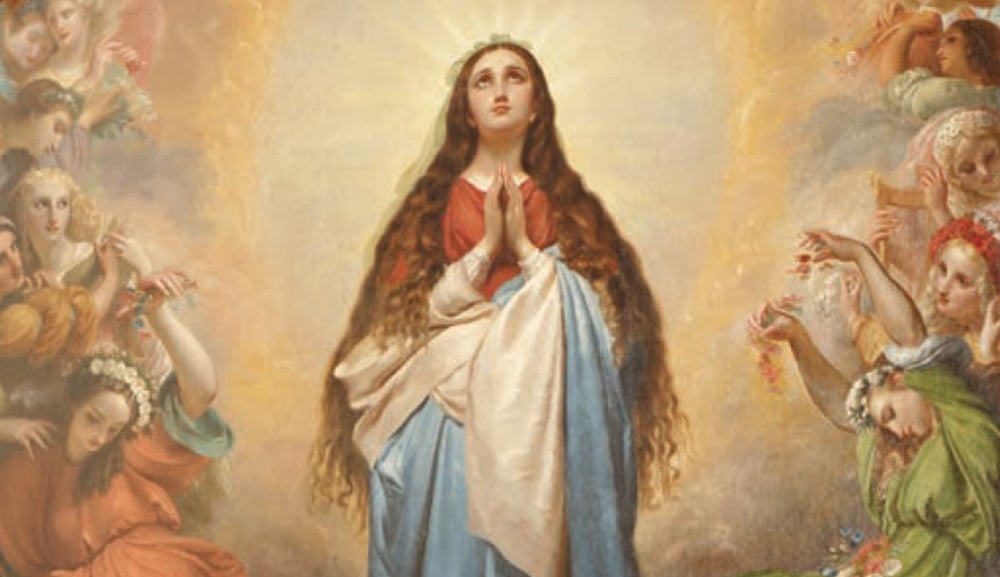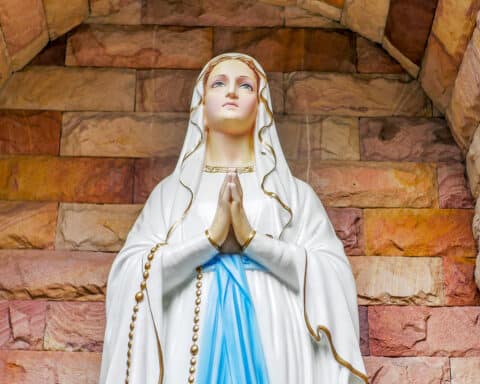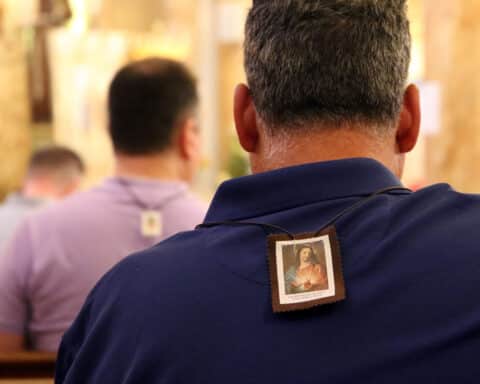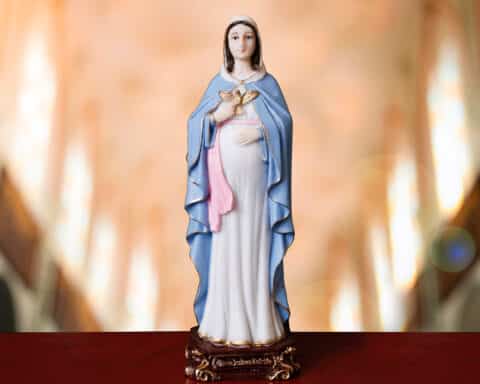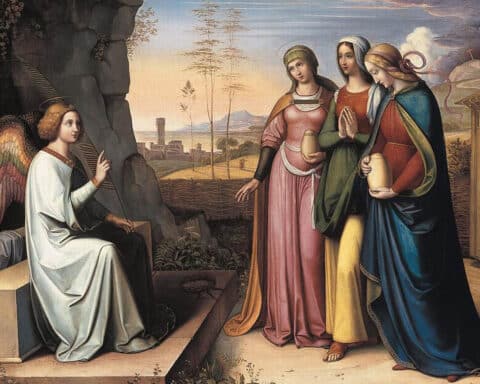Next to Jesus, the most important person who ever lived was Mary — the Blessed Mother. For Catholics, our love affair with her began over 2,000 years ago when an angel visited a young Jewish girl and told her that she had “found favor with God. Behold, you will conceive in your womb and bear a son, and you shall name him Jesus. He will be great and will be called Son of the Most High” (Lk 1: 30-31). Mary’s role in salvation history was fixed from that moment.
Catholic Christians, long before there were institutionalized devotions to Mary, sought ways to seek her intercession, endear themselves to and venerate this holy, pure woman. While those of us today — and those who went before us — esteem and venerate Mary, we never lose our focus on Jesus (Jesus through Mary). The Catechism of the Catholic Church reads, “What the Catholic faith believes about Mary is based on what it believes about Christ, and what it teaches about Mary illumines in turn its faith in Christ” (No. 487). The ardent love we show for her is exemplified in the Marian dogmas proclaimed through the centuries.
Articles of faith
A dogma, described by various sources, is a teaching of the Church that has been revealed by God and a teaching to be held by all Catholics. A dogma is not a new belief, but it clarifies or defines a long-held conviction of the faithful. It often is referred to as a doctrine or article of faith that we all are expected to believe.
According to the Catechism, “The Church’s magisterium exercises the authority it holds from Christ to the fullest extent when it defines dogmas, that is, when it proposes, in a form obligating the Christian people to an irrevocable adherence of faith, truths contained in divine Revelation or also when it proposes, in a definitive way, truths having a necessary connection with these” (No. 88).
There are four Marian dogmas: that Mary is the Mother of God; her perpetual virginity; that she was immaculately conceived; and that she was assumed into heaven.
Our perfect intercessor
In these Marian dogmas, the Church never has taught that Mary is divine; in many ways, other than sin, she is like us. She toiled, laughed, cried and suffered in the manner of every man and woman; thus we easily relate to her.
As she was the spotless tabernacle carrying Our Lord, so we become his tabernacle at holy Communion; as she is the Mother of God, we are her children, the People of God. From conception she was preserved from sin and filled with God’s grace. At baptism our sins likewise are removed and we, too, are filled with grace.
Mary is our perfect intercessor in heaven; though we often fall short of her immaculate life, fall short of her extraordinary sanctity, she gives us hope and the confidence of eternal life. Pope Francis recently acknowledged the continuous, universal love affair we have with Our Lady when he established the Memorial of the Blessed Virgin Mary, Mother of the Church, as an annual feast day to be celebrated on the Monday after Pentecost.
D.D. Emmons writes from Pennsylvania.
Perpetual virgin
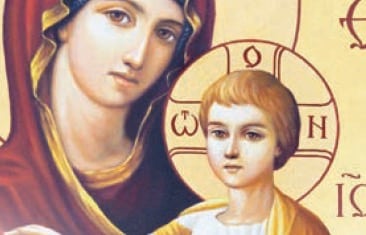 That Mary was a virgin before, during and after the birth of Jesus, a perpetual virgin, is a Marian dogma. In Luke, “The angel Gabriel was sent from God to a town of Galilee called Nazareth, to a virgin betrothed to a man named Joseph” (Lk 1:27).
That Mary was a virgin before, during and after the birth of Jesus, a perpetual virgin, is a Marian dogma. In Luke, “The angel Gabriel was sent from God to a town of Galilee called Nazareth, to a virgin betrothed to a man named Joseph” (Lk 1:27).
The Sacred Scripture clearly identifies Mary as a virgin, and a virgin she wanted to remain. During the Annunciation, she gave her yes to Gabriel after he tells her that she will become a virgin mother through the power of the Holy Spirit and that her kinswomen Elizabeth, who is barren and beyond childbearing years, was six months pregnant. These are miraculous events, and the angel explains the miracles saying, “for nothing will be impossible for God” (Lk 1:37).
Mary will give birth through a supernatural act of God rather than through relationship with a man and thus her virginity remains intact. St. Justin Martyr in the second century wrote, “But the power of God, coming upon the Virgin, overshadowed her, and caused her, while yet a Virgin, to conceive.” God’s glory is magnified through the virgin birth of Jesus. When we contemplate his divinity and his glory, we quickly recognize the purity of the vessel that carried him in her womb.
She was the one “full of grace,” the chosen one who would give birth to the Word made flesh and, as such, committed herself to Jesus. Mary was destined to remain a virgin because of the special role God had given her. Her close relationship with God was similar to the intimate relationship God had with Abraham, with Moses, with David. In her canticle, Mary proclaims, “For he has looked upon his handmaid’s lowliness; behold, from now on will all ages call me blessed” (Lk 1:48).
Some argue that Mary had other children after Jesus, pointing to the Gospel according to Luke 1:7: “She gave birth to her firstborn son.” Firstborn son means the eldest son who has certain family privileges and inheritance rights. Firstborn males also belong to the Lord according to Exodus 13 and Luke 2:23, so therefore Verse 7 of Luke does not mean that Mary had additional children.
The Bible mentioning the brothers and sisters of Jesus has long been considered a reference to cousins, non-blood relatives or individuals spiritually close to the Holy Family. If Jesus had blood-related brothers and sisters, then he would be the son of Joseph. That Mary had no other children, that she was ever virgin, is further indicated by the words of Jesus from the cross: “When Jesus saw his mother and the disciple there whom he loved, he said to his mother, ‘Woman, behold, your son.’ Then he said to the disciple, ‘Behold, your mother.’ And from that hour the disciple took her into his home” (Jn 19:26-27). If Mary had other children, Jesus would have likely chosen one of them to care for his mother.
| Mary’s Virginity Affirmed in History |
|---|
|
The Apostles Creed, from the second century, says the son of God “was born of the Virgin Mary,” and the Nicene Creed, fourth century, proclaims that Jesus “came down from heaven and by the Holy Spirit was incarnate of the Virgin Mary.”
The Church Fathers and councils through the years also affirmed her perpetual virginity.
St. Augustine (354-430) said, “A virgin conceives, yet remains a virgin; a virgin is heavy with child; a virgin brings forth her child, yet she is always virgin. Why are you amazed at this, O man? It was fitting for God to be born thus when he deigned to become man” (Sermon 186). Indeed, why should we be amazed that Mary, the one chosen by God as his mother, would be a perpetual virgin? She was God’s ornate fixture on earth, the new Eve, who would deflect all fame to her Son.
The Fifth Ecumenical Council of Constantinople in 553 called Mary, “the holy and glorious ever virgin.” Then, in 679, following the local Council of Lateran, Pope Martin (r. 649-55) decreed, “If anyone does not properly and truly confess in accord with the holy Fathers, that the holy Mother of God and ever Virgin and Immaculate Mary in the earliest of the ages conceived of the Holy Spirit without seed, namely, God the Word Himself specifically and truly, who was born of God the Father before all ages, and that she incorruptibly bore [Him], her virginity remaining indestructible even after His birth, let him be condemned” (Canon 3).
The Church points to these two councils as the source of the dogma regarding Mary as a perpetual virgin.
|
Mother of God
When an adult joins the Catholic Church, he or she hears many new words and names; one attention getter is “Mary Mother of God.” Such a name takes a little thought and even explanation. How can God have a mother? Well, if we believe that Mary of Nazareth gave birth to Jesus, and that Jesus is the Second Person of the Trinity, of the same substance as God, then calling her the Mother of God makes perfect sense.
Indeed that Mary was the Mother of God is found in the Gospel of Luke (1:39-45), describing Mary’s visit to Elizabeth. When Mary arrives, Elizabeth calls her the “mother of my Lord,” and then two verses later in the visitation story, Elizabeth makes it clear that she is talking about God, saying, “Blessed are you who believed that what was spoken to you by the Lord would be fulfilled.” Most early Christians regarded and honored Mary in this light, but certainly not all.
| Early heresies overcome |
|---|
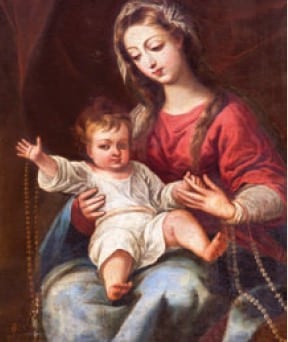 There were those who argued against her divine motherhood, but their arguments were based primarily on who Jesus was and, from that conclusion, denying that Mary was the Mother of God. In the early fourth century, the Arians, led by a monk named Arius of Alexandria, claimed Jesus was not divine but a created being in that he was born of a woman. This was the subject of debate during the first-ever ecumenical council, held in the year 325 at Nicaea, Turkey. The council resulted in Arius being excommunicated. The 318 bishops in attendance proclaimed Jesus to be of the same substance as God and issued the language contained in our Nicene Creed, that Jesus is consubstantial with the Father. From the words of this creed, people concluded what most believed, that Mary was and would be called the Mother of God. Less than 100 years later, the divinity of Jesus again was questioned. The heretic was Nestorius, archbishop of Constantinople from 428-31. He and others, especially of the Antiochian School, claimed that Jesus was two persons, born as a human and then later became divine, and thus, Mary gave birth to a human being and couldn’t be the Mother of God. This all was perplexing to the followers of Christ who thought that the Council of Nicaea had resolved the issue of Christ’s person, that he was one person with two natures — one human and one divine — and that Mary had given birth to this one person. So in 431 another general council was called, this time in Ephesus, Turkey. The majority of bishops, led by Bishop Celestine of Alexandria, attested to the results of Nicaea that Jesus was one person. They condemned Nestorius as a heretic and confirmed that Mary was the Mother of God (In Greek, Theotokos, or God-Bearer). During his general audience on Nov. 27, 1996, Pope St. John Paul II said, “The Council of Ephesus condemned his [Nestorius] thesis and, affirming the substance of the divine and human nature in the one person of the Son, proclaimed Mary the ‘Mother of God.'” This action at Ephesus was a formal proclamation, and on the night of the bishops’ decision, the citizens of Ephesus went through the town joyfully chanting, “Holy Mary Mother of God.” Almost immediately thereafter churches dedicated to the Blessed Mother started being erected, and annual feast days honoring the Virgin became part of the Church year. The dogma of Mary as the Mother of God is traced to the Council of Ephesus and to all those Christians who never doubted that Jesus is God and that Mary is his mother. |
Immaculate Conception
“The faith of the Catholic Church on the subject of the conception of Mary is this: that at the very instant, when God united the Soul of Mary, which he had created, to the body which it was to animate, this ever-blessed soul did not only not contract the stain, which, at the same instant defiles every human soul, but was filled with an immeasurable grace which rendered her, from that moment, the mirror of sanctity of God himself, as far as this is possible to a creature.”
— Dom Gueranger, Advent.
The Church proclaims that Mary was never tainted with sin — that she was conceived in her mother’s womb without the stain of original sin, that she was born and lived without sin.
When the angel appeared to Mary (see Lk 1:28), saying to her, “Hail favored one!” (full of grace), it was not a promise of something in the future. He didn’t say, “You will be filled with grace or favored,” she was already so gifted; that is, she always was infused with divine goodness. The presence of God’s grace, God’s goodness denies even the possibility of evil. Mary was the tabernacle that carried Our Lord for nine months; thus, original sin or any sin could never stain her in the manner of other men and women. The document of the Second Vatican Council Lumen Gentium says, “Adorned from the first instant of her conception with the radiance of an entirely unique holiness, the Virgin of Nazareth is greeted, on God’s command, by an angel messenger as ‘full of grace'” (No. 56).
| History of the Immaculate Conception |
|---|
|
Since the eighth century, the Church has celebrated Mary’s conception in the womb of her mother, and since the 12th century, it has been called the Immaculate Conception. During the middle ages theologians and Church leaders debated as to whether or not Mary was conceived exempt from original sin. People like Albert the Great, St. Thomas Aquinas and St. Bernard of Clairvaux argued that every man and woman experiences original sin and is only redeemed by Jesus’ suffering for us on the cross; thus, Mary couldn’t be redeemed before there was a Redeemer. It was the theologian and Franciscan Blessed John Duns Scotus (1266-1308) who convincingly explained that Mary was preserved in advance from original sin (preserved redemption), that she was redeemed and saved at her conception. He explained that if a person falls, they have to be helped up, but God prevented Mary from falling (redeemed in advance). Simply put, Mary was sinless from her conception by the grace of God. While there was validity in the words of Duns Scotus, the controversy about Mary’s conception continued until 1661 when Pope Alexander VII (r. 1655-67) declared in his papal bull Sollicitudo Omnium that Mary was conceived without sin. Pope Alexander’s declaration was an immensely important document, not only in the 17th century, but also 200 years later when the Church officially defined the Immaculate Conception as a revealed truth from God. In 1708, Pope Clement XI (r. 1700-21) further promoted the annual Dec. 8 celebration by declaring it a holy day of obligation throughout the Roman Church. This long-held belief by Catholic Christians, that Mary was sinless from the moment of her conception, became a dogma of the Church in 1847. After surveying the bishops of the Church and receiving an overwhelming positive response, on Dec. 8, 1847, Blessed Pope Pius IX (r. 1846-78) issued a papal bull, Ineffabilis Deus, proclaiming the dogma of the Immaculate Conception. His bull says, “By the authority of Jesus Christ our Lord, of the Blessed Apostles Peter and Paul, and by our own: ‘We declare, pronounce and define that the doctrine which holds that the most Blessed Virgin Mary, in the instance of her conception, by a singular grace and privilege granted by Almighty God, in view of the merits of Jesus Christ, the Savior of the human race, was preserved free from all stain of original sin, is a doctrine revealed by God and therefore to be believed firmly and constantly by all the faithful.” Through this proclamation, Pius IX exercised his papal infallibility, that is, he was acting on an issue of faith (and morals), speaking without error, from the chair of Peter as the head of the Catholic Church and formally establishing as an article of faith, a belief to be held by all the faithful in the universal Church. Four years later the Blessed Mother would call herself the Immaculate Conception during an apparition to St. Bernadette at Lourdes, France. |
| American Devotion |
|---|
|
The Immaculate Conception was honored by many of the new world explorers. When Christopher Columbus (1451-1506) sailed to the new world in 1492, his flagship was named Santa Maria de la Immaculate Conception or Holy Mary of the Immaculate Conception. The Spanish Conquistador Cortes (1485-1547) founded the first hospital in North America; it was erected in Mexico City in 1524 and originally called the Hospital of the Immaculate Conception. In 1673, Jesuit Father Jacques Marquette (1637-75), a French explorer in the upper Midwest, discovered the northern portion of the Mississippi River and named it the River of the Immaculate Conception. St. Junipero Serra (1713-84) wrote a novena to Mary’s Immaculate Conception in 1765 while serving as a missionary in California. In 1864, the bishops of the United States petitioned the Holy See and received permission to use the name Our Lady of the Immaculate Conception as patroness of the United States. This was eight years before the pope used his authority to declare the Immaculate Conception as a dogma of the Church. |
Assumption
That Mary was assumed into heaven is the oldest of all the Marian beliefs and can be traced back to the Apostles, many who were alive at time of her passing. The term assumed, as used by the Church, means that when her life on earth ended, Mary did not suffer the decay of the grave but was taken into heaven by God. That her body did not corrupt in a tomb is in keeping with her role as the sinless, immaculate Virgin Mother of God. The Eastern Church calls her passing the Dormition of Mary (Latin for falling asleep) and began celebrating a feast by that name in the fourth or fifth century. By the seventh century the Western church added this feast and later the name was changed to the feast of the Assumption.
According to Cardinal John Henry Newman (1801-90), “By her assumption is meant that not only her soul, but her body also, was taken up to heaven upon her death, so that there was no long period of her sleeping in the grave, as is the case with others, even great saints, who wait for the last day for the resurrection of their bodies.”
Catholics traditionally commemorate the life of a saint on the anniversary of that person’s death. The first Christians would congregate at the tomb or site where the saint’s relics were buried and in special ways remember that individual. In the case of Mary, the holiest and most beautiful of all our saints, there is no clear evidence of how or when she died; no remains, no relics. Some historians think she died in Ephesus primarily because St. John lived there and cared for Mary as requested by Jesus from the cross. Other historians, probably in the majority, maintain that she died in Jerusalem.
| Debate over the Assumption |
|---|
|
One early debate about Mary’s assumption concerned whether or not she actually experienced death. It was said by some that everyone dies, yet if death is the result of sin (Rom 6:23), how could the sinless Mother of God die? St. Andrew of Crete (660-726) explained: “Death, natural to men, also reached her; not, however, to imprison her, as happens to us, or to vanquish her, God forbid! It was only to secure for her the experience of that sleep which comes from on high, leading us up to the object of hope. … No man lives, says Scripture, who will not see death. But even though the human creature we celebrate today must obey the law of nature, as we do, she is superior to other humans. Therefore, death does not come to her in the same way it comes to us. Instead, it comes in a superior way, and for a reason higher than the reasons that oblige us to surrender totally to death.” Defining the Assumption of the Blessed Mother as an article of faith was promoted in the Church for centuries. During the First Vatican Council (1869-70), 195 bishops petitioned the council to take such action. But the effort at the time was not advanced; less than a century later it was. Historians say the increasing emphasis on Mary that evolved throughout the Church between 1850 and 1950 was stimulus for establishing the Assumption dogma. During those 100 years, sometimes referred to as the era of Mary, the dogma of the Immaculate Conception had been proclaimed (1854), the apparitions of Lourdes (1858) and Fatima (1917) occurred and the popularity of the Rosary spread, all galvanizing the faithful toward the Blessed Mother. In that time, the world witnessed the Russian Revolution, two world wars and the Holocaust, all of which had a destructive impact on respect for human life. The Cold War of the 20th century, replete with nuclear weapons and the terrors associated with those weapons, was threatening the world. People hungered for hope. Throughout the 19th and 20th centuries, thousands of petitions flooded the Vatican encouraging the pope to define the Assumption as an official article of faith. In 1946 Pope Pius XII (r. 1939-58) proposed making the Assumption a dogma of faith to some 1,200 bishops, and the response overwhelmingly was positive. On the feast of All Saints, 1950, Pope Pius XII, speaking ex cathedra through his infallible authority, publicly proclaimed the dogma of the Assumption and issued the bull Munificentissimus Deus (“The Most Beautiful God”). The pope declared the Assumption of Mary to be “divinely revealed dogma: that the Immaculate Mother of God, the ever Virgin Mary, having completed the course of her earthly life, was assumed body and soul into heavenly glory” (No. 44). The papal bull legitimized an ancient, ongoing and common belief of the faithful. It publicly proclaims a core, distinguishable tenet of Catholicism. Pius XII does not try to convince us how Mary departed this life. He does, however, clearly describe the Assumption as an article of faith to be believed by all the Catholic faithful; to that end, the pope added, “Hence if anyone, which God forbid, should dare willfully to deny or to call into doubt that which we have defined, let him know that he has fallen away completely from the divine and Catholic Faith” (No. 45). |

